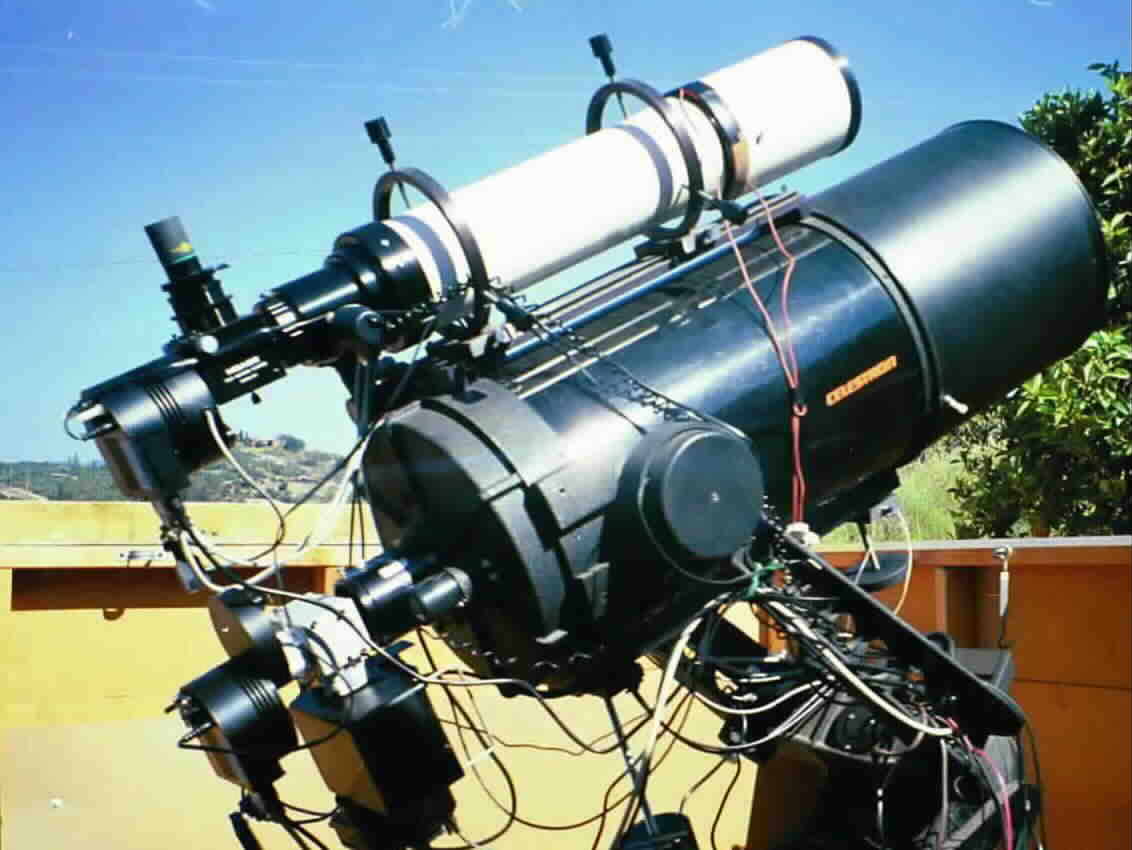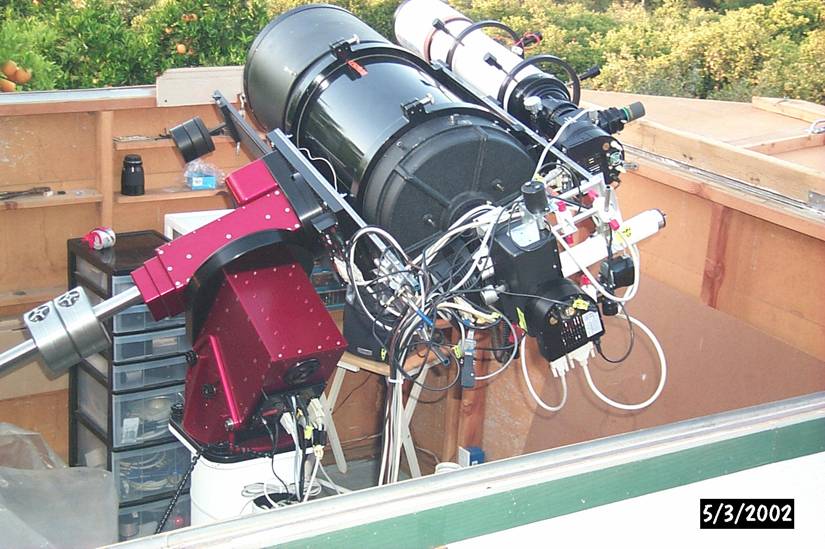






The era's of my astronomy life
Photography (silver based) era: 1968-1991
Imaging Transition era: 1991-1995
CCD Imaging era: 1995-2000
CCD Spectroscopy era: 1999-Present
Precision Photometry era: 2002-Present
Making the Transition from Film
to CCD ImagingI have spent more years in amateur astronomy and in particular astrophotography than my wife of 19 years probably cares to remember. In the sixties, using simple equipment, I concentrated on the moon and wide field piggyback photography using an old Brownie box camera and either tri-X or plus-X film. Following a leave of absence from astronomy while pursuing my education, the late 70's and early 80's were spent using the Kodak spectroscopic films on more sophisticated equipment. Most of these efforts were spent using guide scopes on a variety of instruments. In spite of tremendous efforts on my part to make this type of photography work, I was never able to completely solve the problems associated with flexure between the main and guide scopes. In 1984 I purchased a giant-easy guider from Lumicon for off-axis guiding. Immediately, I began to get desirable results using a Celestron 11. During the next 6 years, I fell into a pleasant routine of photographing a wide variety of celestial wonders primarily using hypered 2415.
In the early eighties when hyper-sensitizing of film was just beginning, I began experimenting on my own. My profession (pharmacologist) always allowed me to have easy access to good vacuum pumps and hydrogen gas at my various places of employment. I established my own system for hypering film with pure hydrogen gas which produced the desired level of sensitivity and after experimenting with a variety of films settled on tech pan 2415 (like everybody else). Much has been written about this procedure, but I found it unnecessary to unroll individual rolls of film. In addition, by substituting length of exposure to the gas for heating, I could get the same level of hypering. I found that I could hyper a 6-8 exposure roll of 2415 in the film canister in 8 days in pure hydrogen at room temperature. By using a large glass dessicator with a vacuum port, I could hyper 15-20 rolls at a time. I simply placed the film in the dessicator, pumped out the air for about 15 minutes and then using a balloon which I had filled with hydrogen, bled the gas back into the evacuated dessicator until ambient pressure was obtained. After 8 days, the film was removed, tested and stored away in a freezer until used. The film prepared this way was good even after 2 years storage.
The appearance of auto-guiders (ST-4) in early 1990 was a God send for those of use doing 60-120 minute hand guided exposures. While it made astrophotography much easier, it also points out the shortcomings in your drive system. While I could hand guide through the drive errors on my C-14 drive system and still get good pictures, the drive was incapable of keeping the guide star on the small CCD chip, so my initial attempts at auto-guiding were fruitless. A Byers C-14 retrofit solved this problem and soon the ST-4 became the workhorse of my astrophotography endeavors for the next 5 years. Coupling this to a computer in my observatory made locating and monitoring the guiding process much easier. Each time a correction is made, the computer places an + to indicate the position of drift away from the starting point of the guiding procedure and these +'s accumulate such that by the end of a long exposure a blur circle has been generated indicating how good your system has performed AND how good the seeing is at the time of the exposure. Since my drive system is very good now and since I have a permanent set up with my observatory and am polar aligned, the size of this "blur circle" is a good indication of the seeing and predicts how sharp the star images will be on the negative. Using this system on a steady night, I could typically guide within a circle of just a few arc seconds for an indefinite period of time. Sky fog limits my exposures to no more than 120 minutes when working at f6.5.
Alas, technology was overtaking me and I began to get interested in the CCD cameras as actual imagers. I never actually used the ST-4 to acquire an image. For me it was simply a tool to keep the emulsion locked on a star. As the area of the imagers increased and the pixel size decreased I became more interested. When Meade announced their new line of cameras based on the Kodak chips with 9 micron pixel resolution, I began to get very interested. I very nearly purchased one of these cameras but my inability to get in touch with Meade to talk "shop" and ask questions along with the fact that the availability of the cameras was stalled well beyond the point that they began advertising put me on hold. Shortly thereafter, SBIG announced their equivalent version with a very important novel feature: an additional chip which allowed for simultaneous imaging and auto-guiding, I knew the time had come to give this new imaging technology a try so I purchased an ST-7.
Previous Equipment, up to 2002

Current Setup 2002-Present

Celestron 14 working at f6, Paramount ME
Astrophysics 5.1, f6
SBIG ST-10XMe, ST-8e, Self-guiding Spectrometer
Van Slyke flip mirror which switches between spectrometer and ST-8e
In Image processing of my images, much experimentation is needed. I acquire my images using the software package MaxIm. Following dark and flat field corrections within MaxIm, I use CCDSOFT to perform the Lucy-Richardson algorithm which does a great job sharpening up stars without introducing all the artifacts which in my experience come with maximum entropy routines. Finally I go back into MaxIm to perform the final "tweeking" of the image with one or more of the outstanding routines available with MaxIm. MaxIm would be complete in my opinion if it had the Lucy-Richardson routine available. It does have maximum entropy deconvolution but I have never been able to get it to work well and not introduce artifacts into my images.
Images with Celestron 14:
Images with AstroPhysics 5.1: